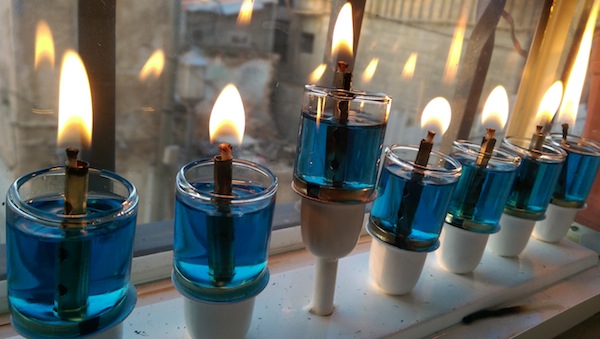The reason that is ascribed to the House of Hillel for the custom that we follow in lighting the candles is that we go upwards in holiness. (photo by Maor X)
Hanukkah lives in the sweet spot where there is one story that claims it is “historically true” and yet there is very little contemporary evidence to back this up – the earliest account being written generations after the events – and there is another story, a miracle story whose earliest recording is centuries after its supposed occurrence. We go with the miracle story.
There was no love lost between the rabbis and the Hasmoneans. There are several legends about rabbis (i.e. Shimon ben Shatah) confronting the Hasmonean king Yannai (e.g. Sanhedrin 19a-b) and Yannai killing sages (Kidushin 66a). So, it is not surprising that the rabbis did not glorify the Hasmonean victory, and chose to centre a different legend, which seems to have arisen in the first centuries of the common era. The additional prayer (called Al Hanisim) that is added to the central prayer does not mention the miracle of the oil. The earliest mention of the miracle of the oil is in the commentary (the “scholion”) to a first-century list of holidays called Megillat Ta’anit. This commentary is not mentioned in the Palestinian Talmud. Its first appearance is in the Babylonian Talmud many centuries later.
While this may point to a choice for the miracle story over the martial story, the martial story did not fade away. It arose from time to time, gaining full rehabilitation with the birth of the Zionist movement, whose adherents looked to the Maccabees for ancestral precedent. However, this is not my point.
The earliest rabbinic legal discussion of the obligations of Hanukkah (as opposed to mentioning Hanukkah in passing) is not in the Palestinian Mishnah. It is in a supposed Palestinian baraita (“outside” teaching) quoted in the Babylonian Talmud and not in the Palestinian Talmud. This is the famous debate between the House of Hillel and the House of Shammai as to whether one lights one candle on the first night and then adds a candle each night (Hillel); or, conversely, one lights eight candles on the first night and then subtracts a candle each night (Shammai). This is followed by the obligation to light the candelabrum in the doorway, outside or, if one lives on an upper floor, in the window.
These are the earliest legal discussions of Hanukkah. There are others. The salient point is that many of the laws have to do with the placement of the candelabrum in order to publicize the miracle (pirsumei nisa). One might have thought that a holiday whose legend included the purification of the Temple would have had a Temple-like ritual at its centre. Instead, even the candelabrum does not replicate the seven-branched Temple candelabrum. The focus of the holiday obligations is marking Jewish space. Facing outward at the moment that people return from the market. If one has two entrances, the Talmud asks, does one have to light in both places?
Hanukkah is a diasporic holiday that celebrates place. This place where we are now is the place in which we announce the miracle. This is not a second-rate reminder of a ritual whose better form would have been and will be ensconced in the Temple. It is a diasporic ritual that lays claim to diasporic Jewish space.
This places Hanukkah on the same axis as Purim, again a holiday that is about and in Diaspora, and would not make sense in the Land of Israel. However, the difference is Purim posits that redemption is impossible and that, as long as the king is maliciously or foolishly evil, there will be a never-ending drama in which first Haman succeeds and then Mordecai succeeds. Hanukkah celebrates the fact of being here. Light in whatever many religious or secular metaphors it is clothed is brought into these Jewish spaces. The reason that is ascribed to the House of Hillel for the custom that we follow in lighting the candles is that we go upwards in holiness and not the opposite. We light the candles and increase the holiness. Here.
Hanukkah is a diasporic holiday in that it is portable. The celebration of Hanukkah defines the space that is celebrated as a Jewish space – like a mezuzah on a doorpost or an eruv (ritual boundary) in a city. Like these other markers, it creates Jewish space that is non-exclusive. Jewish space that has permeable boundaries. Jewish space that lives in proximity to others, despite the fact that this proximity is risky. From the start, the halakhah (Jewish law) of Hanukkah decided that, in a time of danger, one need not light the candelabrum on the outside or facing out, rather one may light inside on a table.
When we light candles today, we again announce that we live in Jewish spaces that are proximate to other spaces and, while we embrace this proximity, we are aware that it is risky – and yet still we increase the holiness, the light, from day to day. Here, in this time, and in this place.
Rabbi Aryeh Cohen is a fellow of the Kogod Research Centre at the Shalom Hartman Institute of North America and professor of rabbinic literature at the Ziegler School of Rabbinic Studies of the American Jewish University, where he teaches courses in Talmud. He is also the rabbi in residence for Bend the Arc: Jewish Action in Southern California. For more articles by Cohen, visit jewschool.com, where the original of this article can be found. For articles by other Shalom Hartman scholars, visit hartman.org.il.

